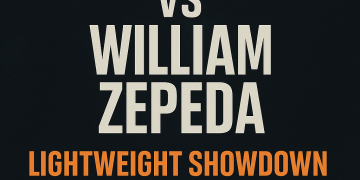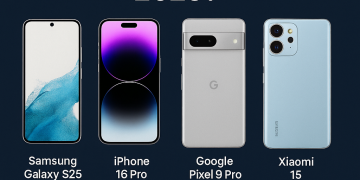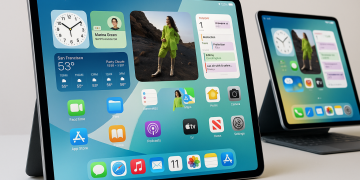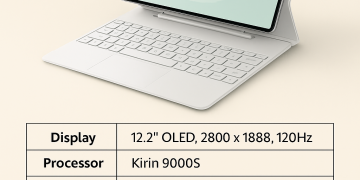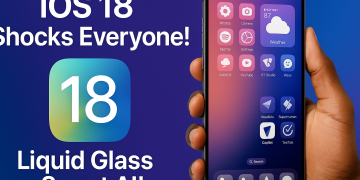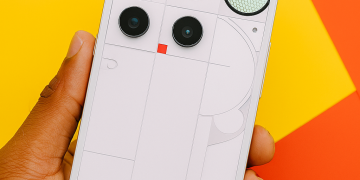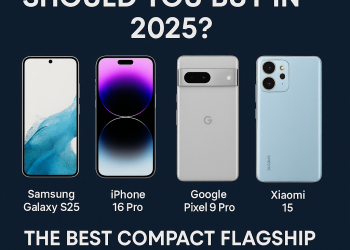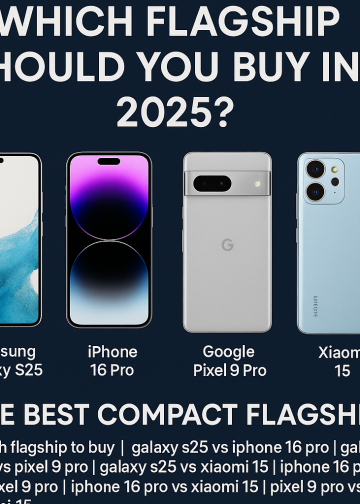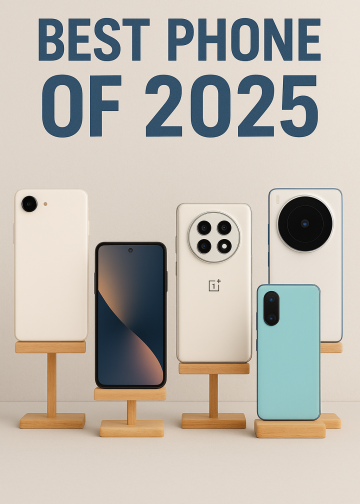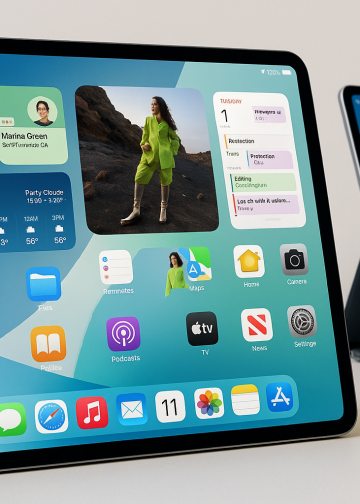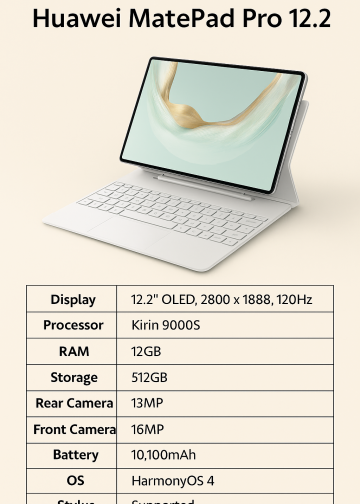Introduction: The Compact Flagship Face-Off Begins
In the world of smartphones, the compact flagship segment is heating up in 2025, and no two devices are commanding more attention than the Samsung Galaxy S25 and Apple iPhone 16 Pro. Both represent the pinnacle of their respective ecosystems—Android and iOS—and they come packed with the latest innovations in design, performance, and camera technology. But if you’re shopping for the best compact flagship of the year, the question is clear: Galaxy S25 vs iPhone 16 Pro—who takes the crown?
On the surface, both phones are similarly priced and designed for premium users who prefer smaller form factors without sacrificing power. Each brings its A-game: Samsung touts the Snapdragon 8 Gen 4 for Galaxy, an upgraded cooling system, and camera AI enhancements, while Apple counters with the blazing-fast A18 Pro chip, improved periscope telephoto lens, and new iOS 19 features.
But flagship shopping isn’t about specs alone—real-life performance, usability, ecosystem integration, and future-proofing are key considerations. Whether you’re an Android fan debating a switch, or an iPhone user considering something new, this guide will break down everything that matters in this Galaxy S25 vs iPhone 16 Pro battle.
Over the next sections, we’ll dive deep into design, display, camera comparisons, performance tests, and battery life. We’ll even pit both phones against other rivals like the Pixel 9 Pro and Xiaomi 15, helping you decide once and for all which flagship to buy in 2025.
Design & Build Quality: Premium Looks Meet Practical Durability
When choosing between the Galaxy S25 and iPhone 16 Pro, design plays a huge role—especially in the compact flagship category, where ergonomics and in-hand feel matter just as much as specs.
Samsung has opted for a refined version of the Galaxy S24’s design, but slimmer and more angular. The Galaxy S25 features an aluminum armor frame with slightly curved edges that make it comfortable to hold. It’s also one of the lightest flagships in its class, and despite the thin profile, it retains a massive vapor chamber for improved thermals—a big deal for gamers and power users alike.
Meanwhile, Apple sticks with its signature flat-edged industrial design. The iPhone 16 Pro introduces Liquid Metal Titanium 2, making it both lighter and stronger than its predecessor. It feels incredibly solid in the hand, though its squared corners may not be everyone’s favorite. However, it’s undeniably premium—and the new muted color palette looks elegant in any light.
Both phones offer IP68 water and dust resistance, which is now standard at the flagship level. But Samsung gets a slight edge with its matte textured back that repels fingerprints better than Apple’s glossy finish.
If you’re deciding which flagship to buy purely based on looks and comfort, the choice becomes personal. The Galaxy S25 feels more futuristic and ergonomic, while the iPhone 16 Pro maintains that iconic, precision-cut Apple feel. For many, this comes down to ecosystem preference—but on design alone, both are true compact flagship contenders in every sense.
Display & Multimedia Experience: Clarity Meets Color Science
In the realm of compact flagships, screen quality is a deal-breaker. Whether you’re streaming content, gaming, or just scrolling, both the Galaxy S25 and iPhone 16 Pro offer exceptional display technology—but with very different approaches.
The Galaxy S25 boasts a stunning 6.1-inch Dynamic AMOLED 3X display, offering a buttery smooth 144Hz adaptive refresh rate, 2,600 nits of peak brightness, and a QHD+ resolution. Samsung’s punchy color tuning and deep blacks make it ideal for consuming HDR content. Watching YouTube or Netflix on the Galaxy S25 is a visual treat—colors pop, shadows are rich, and motion feels fluid. The screen also supports LTPO tech, dropping to 1Hz when idle to save battery.
On the other hand, the iPhone 16 Pro features a 6.1-inch Super Retina XDR OLED panel with ProMotion 120Hz and peak brightness of 2,500 nits. While Apple sticks to a slightly lower resolution, its color calibration is industry-leading. Content creators will appreciate the natural color reproduction and consistent white balance. It also shines in direct sunlight, thanks to its new anti-reflective coating.
Multimedia lovers will enjoy stereo speakers on both devices—though Samsung delivers slightly more bass-heavy audio, while Apple’s sound profile is cleaner and brighter.
In the end, if you prefer vibrant, contrast-rich visuals and high refresh rates, the Galaxy S25 display might win you over. If you’re a creator or photo editor who values color accuracy and visual consistency, the iPhone 16 Pro makes a compelling case.
It’s worth noting: in Galaxy S25 vs iPhone 16 Pro camera test scenarios, the display itself impacts how you perceive your own photos—so visual accuracy matters.
Performance & Benchmarks: Raw Power vs Real-World Speed
When it comes to performance, the Galaxy S25 vs iPhone 16 Pro debate gets more intense. Each device runs on cutting-edge silicon, pushing the limits of mobile computing in different ways.
Samsung’s Galaxy S25 ships with the Snapdragon 8 Gen 4 for Galaxy globally, skipping Exynos altogether this year. Built on a 3nm process, it offers up to 20% better CPU performance and a whopping 30% boost in GPU power compared to the S24. Paired with a new vapor chamber cooling system, the S25 remains cool under stress—even during gaming sessions. In Geekbench tests, it hits impressive multi-core scores north of 7,000.
Meanwhile, Apple’s A18 Pro chip inside the iPhone 16 Pro is no slouch. Apple focuses more on efficiency and peak single-core performance, which is evident in its benchmark dominance. In single-core Geekbench scores, the iPhone 16 Pro leads the industry, making it a beast for tasks like video editing, augmented reality apps, and gaming. Apple’s Metal API continues to deliver smoother gameplay in supported titles.
In performance tests, both phones fly through everyday tasks, but they prioritize differently: Samsung pushes for raw horsepower and gaming fluidity, while Apple optimizes for power efficiency and consistent thermal control.
Gaming enthusiasts will appreciate the Galaxy S25’s active cooling and higher sustained frame rates in long sessions. On the flip side, content creators may prefer the iPhone 16 Pro’s seamless rendering and editing workflows.
If your priority is future-proof performance, the Galaxy may offer more headroom, while the iPhone focuses on delivering a consistently fast, cool, and stable experience.
Camera Features & Real-World Tests: Which Flagship Shoots Best?
If there’s one area that truly defines the flagship battle in 2025, it’s the camera. Both the Galaxy S25 and iPhone 16 Pro come packed with upgraded lenses, smarter AI processing, and pro-level features—but which one captures the best shots?
The Galaxy S25 introduces a new 50MP main sensor with larger pixels, improved OIS, and Samsung’s fifth-gen image signal processor. It also packs a 12MP ultra-wide and a new 3x telephoto lens with AI-powered digital zoom that competes with periscope lenses in clarity. In daylight, shots are vibrant and detailed with strong dynamic range. In low light, Samsung’s Nightography 3.0 takes cleaner, less noisy photos with faster shutter response.
The iPhone 16 Pro, on the other hand, features a 48MP main sensor, a new ultra-wide with better low-light sensitivity, and a powerful tetraprism telephoto lens capable of 5x optical zoom. Apple leans heavily on computational photography and its new Photonic Engine 2.0 to produce shots with natural tones and better skin texture in portraits. In real-world camera tests, it often delivers more accurate colors, while the Galaxy produces punchier, more dramatic images.
When comparing video quality, Apple still holds the edge with smoother transitions, better audio capture, and cinematic mode at 4K/60fps. However, Samsung closes the gap with 8K video, advanced stabilization, and HDR10+ support.
In side-by-side Galaxy S25 vs iPhone 16 Pro camera test comparisons, it’s clear both phones excel—but appeal to different types of users. Creatives may lean toward Apple for its consistency, while enthusiasts may prefer Samsung’s versatility and vibrant image profile.
Battery Life & Charging: Endurance Meets Efficiency
In a world where smartphones double as cameras, gaming consoles, and productivity hubs, battery life is more important than ever. Thankfully, both the Galaxy S25 and iPhone 16 Pro have made serious improvements in this department for 2025—but they take very different approaches.
Samsung equipped the Galaxy S25 with a 4,500mAh battery, slightly larger than its predecessor, and paired it with AI-based battery optimization that learns your usage patterns over time. Combined with the Snapdragon 8 Gen 4’s efficiency, this leads to an average of 6.5 to 7 hours of screen-on time under moderate to heavy use. In a Galaxy S25 performance test, the phone handled a day of gaming, photography, and streaming without dipping below 15% by bedtime.
On the charging front, Samsung supports 45W fast charging and 25W wireless charging, plus reverse wireless charging for accessories. You can top up from 0% to 100% in about 55 minutes with a compatible charger.
The iPhone 16 Pro, with its 3,950mAh battery, benefits from the A18 Pro chip’s power efficiency and iOS 19’s smarter background process handling. In real-world battery tests, the iPhone lasts nearly as long as the Galaxy S25, despite its smaller cell. You’ll still get 6+ hours of screen-on time, especially with adaptive refresh rate scaling.
Apple’s 27W wired charging is slower on paper, but optimized charging algorithms prevent heat buildup and extend battery health over time. It also supports 15W MagSafe wireless charging, though no reverse charging.
In the end, if you prioritize faster top-ups and larger capacity, Galaxy S25 takes the lead. But if long-term battery health and smart efficiency matter more, the iPhone 16 Pro is a strong competitor.
How Do Pixel 9 Pro and Xiaomi 15 Compare? The Four-Way Battle
While the spotlight is often on the Galaxy S25 vs iPhone 16 Pro, ignoring the Pixel 9 Pro and Xiaomi 15 would be a mistake. These two Android flagships have quietly raised the bar in 2025—especially in camera software and performance.
The Pixel 9 Pro continues Google’s tradition of computational photography excellence. Its 50MP main sensor is paired with Google’s custom Tensor G4 chip, which excels at AI-powered image processing. In Pixel 9 Pro camera tests, results consistently show lifelike tones, incredible dynamic range, and unmatched night photography. However, the Tensor chip still lags behind in raw power and thermal control when compared to Snapdragon 8 Gen 4 or Apple’s A18 Pro.
On the other hand, the Xiaomi 15 is a performance beast. Sporting the same Snapdragon 8 Gen 4 as the Galaxy S25, it pushes even harder with active cooling and a larger 4,800mAh battery. In Xiaomi 15 performance tests, the phone ranks among the fastest Androids in both gaming and multitasking benchmarks. It also impresses with a Leica-tuned camera system, which adds pro-level tuning to its images.
In direct comparisons:
- Galaxy S25 vs Pixel 9 Pro – Samsung wins in performance and display, Pixel leads in photo consistency.
- Galaxy S25 vs Xiaomi 15 – Xiaomi is faster and has better battery, but Samsung wins on UI polish and software updates.
- iPhone 16 Pro vs Pixel 9 Pro – iPhone leads in video and raw speed; Pixel excels in AI and low-light photography.
- iPhone 16 Pro vs Xiaomi 15 – Apple offers ecosystem tightness; Xiaomi offers better performance per dollar.
Bottom line? The best flagship to buy in 2025 may not be obvious—it depends on what you prioritize.
Conclusion: Which Compact Flagship Should You Buy in 2025?
After putting the Galaxy S25, iPhone 16 Pro, Pixel 9 Pro, and Xiaomi 15 through detailed comparisons in real-world conditions, one truth becomes clear: there’s no one-size-fits-all answer.
If you’re after the best all-rounder, the Galaxy S25 is tough to beat. It strikes a fantastic balance between performance, display quality, camera flexibility, and fast charging. For Android fans who want power and polish, this is the one.
For those embedded in the Apple ecosystem or who value video recording, long-term software support, and app optimization, the iPhone 16 Pro still rules. It’s also an excellent pick for content creators and mobile filmmakers thanks to its advanced cinematic tools and the unbeatable A18 Pro chip.
If photography is your main concern, especially in low light, the Pixel 9 Pro deserves your attention. Its computational photography is still unmatched, and it delivers professional-looking shots with minimal effort. However, it may lag behind in gaming and multitasking.
Power users and gamers should keep a close eye on the Xiaomi 15. It brings flagship-tier hardware at a more competitive price. It may lack the brand prestige of Samsung or Apple, but it outperforms many rivals in raw benchmarks.
Ultimately, choosing which flagship to buy in 2025 comes down to your personal needs:
- Prefer Android with balanced features? → Galaxy S25
- Need unmatched video and ecosystem reliability? → iPhone 16 Pro
- Love effortless photography? → Pixel 9 Pro
- Want high performance at lower cost? → Xiaomi 15
Whichever you choose, 2025 is shaping up to be an incredible year for smartphones—and there’s never been a better time to upgrade.

















